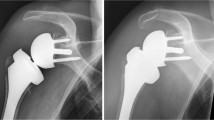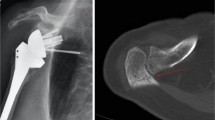Abstract
Background
Reverse total shoulder arthroplasty (RTSA) implants have been developed to treat patients with deficient rotator cuffs. The nature of this procedure’s complications and how these complications should be managed continues to evolve. Fractures of the scapula after RTSA have been described, but the incidence and best methods of treatment are unclear.
Questions/purposes
We therefore (1) determined the incidence and (2) developed a classification system intended to suggest the best choice of treatment.
Patients and Methods
We reviewed the records of 400 patients treated with RTSA over 4.5 years and identified all patients with scapula fractures. We identified three discrete patterns: avulsion fractures of the anterior acromion (Type I); fractures of the acromion posterior to the acromioclavicular joint (Type II); and fractures of the scapular spine (Type III).
Results
Twenty-two patients (5.5%) had fractures. Eight (2.0%) had Type I fractures on the first followup radiographs; these patients were treated nonoperatively with resolution of symptoms. Ten (2.5%) had Type II fractures a mean of 10.8 months after RTSA; seven of the 10 were treated surgically with improvement in their clinical symptoms. Four (1%) had Type III fractures at a mean of 10.3 months; all four fractures were treated with surgical fixation with healing.
Conclusions
Scapula fracture is a relatively common complication of RTSA. Our observations suggest Type I fractures can be observed with a likelihood of symptom relief. For Type II fractures, we recommend acromioclavicular joint resection if stable but open reduction internal fixation if unstable. We believe Type III fractures are best treated with open reduction internal fixation.
Level of Evidence
Level II, prognostic study. See Guidelines for Authors for a complete description of levels of evidence.





Similar content being viewed by others
References
Bohsali K, Wirth M, Rockwood C. Complications of total shoulder arthroplasty. J Bone Joint Surg Am. 2006;88:2279–2292.
Frankle M, Siegal S, Pupello D, Saleem A, Mighell M, Vasey M. The reverse shoulder prosthesis for glenohumeral arthritis associated with severe rotator cuff deficiency. A minimum two-year follow-up study of sixty patients. J Bone Joint Surg Am. 2005;87:1967–1705.
Grammont P, Baulot E. Delta shoulder prosthesis for rotator cuff rupture. Orthopedics. 1993;16:65–68.
Matsen FA, Boileau P, Walch G, Gerber C, Bicknell RT. The reverse total shoulder arthroplasty. Inst Course Lect. 2008;57:167–174.
Nwakama A, Cofield R, Kavvanagh B, Loehr J. Semiconstrained total shoulder arthroplasty for glenohumeral arthritis and massive rotator cuff tearing. J Shoulder Elbow Surg. 2000;9:302–307.
Rittmeister M, Kerschbaumer F. Grammont reverse total shoulder arthroplasty in patients with rheumatoid arthritis and nonreconstructible rotator cuff lesions. J Shoulder Elbow Surg. 2001;10:17–22.
Seebaur L, Walter W, Key W. Reverse total shoulder arthroplasty for the treatment of defect arthropathy. Oper Orthop Traumatol. 2005;17:1–24.
Sirveaux F, Favard L, Oudet D, Huquet D, Walch G, Mole D. Grammont inverted total shoulder arthroplasty in the treatment of glenohumeral osteoarthritis with massive rupture of the cuff. J Bone Joint Surg Br. 2004;86:388–385.
Werner C. Stienmann P, Gilbart M, Gerber C. Treatment of painful pseudoparesis due to irreparable rotator cuff dysfunction with the Delta III reverse-ball-and-socket total shoulder prosthesis. J Bone Joint Surg Am. 2005;87:1476–1486.
Author information
Authors and Affiliations
Corresponding author
Additional information
One of the authors (LAC) has received royalties and consulting fees from Exactech (Gainesville, FL) for a product related to this study.
Each author certifies that his institution has approved the human protocol for this investigation, that all investigations were conducted in conformity with ethical principles of research, and that informed consent for participation in the study was obtained.
This work was performed at Wright State University Boonshoft School of Medicine, Dayton, OH, USA, and the Medical College of Georgia, Augusta, GA, USA.
About this article
Cite this article
Crosby, L.A., Hamilton, A. & Twiss, T. Scapula Fractures After Reverse Total Shoulder Arthroplasty: Classification and Treatment. Clin Orthop Relat Res 469, 2544–2549 (2011). https://doi.org/10.1007/s11999-011-1881-3
Published:
Issue Date:
DOI: https://doi.org/10.1007/s11999-011-1881-3




